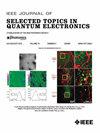自校准智能OCT-SLO系统
IF 5.1
2区 工程技术
Q1 ENGINEERING, ELECTRICAL & ELECTRONIC
IEEE Journal of Selected Topics in Quantum Electronics
Pub Date : 2025-04-03
DOI:10.1109/JSTQE.2025.3557860
引用次数: 0
摘要
在一种独特的光学相干断层扫描和多光谱扫描激光检眼镜(OCT-SLO)混合系统上测试了一种独特的独立于样本的3D自校准方法。采用提出的全新全自动人工智能驱动系统设计,将操作员的视觉认知取代为计算机视觉。样品特定的自动对比度调整/聚焦光束是在预先指示的兴趣区域上实现的。人工智能模型通过定量估计预先指示的特征,致力于红外,荧光和视光谱光学校准。然而,经过测试的方法足够灵活,可以利用任何合适的人工智能模型。与经典的信号-噪声驱动的自动化相比,其性能比人工智能驱动的方法低约200%,慢约130%。该系统的最佳空间分辨率为:(a)玻璃珠眼影2.41微米,小鼠视网膜轴向0.76 $ \pm $ 0.46微米,(b)在冠状/正面/x-y面488nm、840nm和520 - 550nm三个光谱上均优于228线对/毫米(lp/mm)或2微米。智能自动化降低了发生冷白内障的可能性(特别是在小鼠成像中)和由于手动校准过程中的延迟而导致的患者相关不适,从而促进了快速眼部成像和更高的准确性。自动新颖的桌面紧凑系统为动态样品配置文件提供三种不同光谱的真正功能3D图像。这对于光动力成像治疗尤其有用。本文章由计算机程序翻译,如有差异,请以英文原文为准。
Self-Calibrating Intelligent OCT-SLO System
A unique sample-independent 3D self-calibration methodology is tested on a unique optical coherence tomography and multi-spectral scanning laser ophthalmoscope (OCT-SLO) hybrid system. Operators’ visual cognition is replaced by computer vision using the proposed novel fully automatic AI-driven system design. Sample-specific automatic contrast adjustment/focusing of the beam is achieved on the pre-instructed region of interest. The AI model dedicates infrared, fluorescence, and visual spectrum optical alignment by quantitatively estimating pre-instructed features. The tested approach, however, is flexible enough to utilize any apt AI model. Relative comparison with classical signal-to-noise-driven automation is shown to be ∼200% inferior and ∼130% slower than the AI-driven approach. The best spatial resolution of the system is found to be: (a) 2.41 microns in glass bead eye phantom, 0.76 $ \pm $ true functional 3D images in three different spectrums for dynamic sample profiles. This is especially useful for photodynamic imaging treatment.
求助全文
通过发布文献求助,成功后即可免费获取论文全文。
去求助
来源期刊

IEEE Journal of Selected Topics in Quantum Electronics
工程技术-工程:电子与电气
CiteScore
10.60
自引率
2.00%
发文量
212
审稿时长
3 months
期刊介绍:
Papers published in the IEEE Journal of Selected Topics in Quantum Electronics fall within the broad field of science and technology of quantum electronics of a device, subsystem, or system-oriented nature. Each issue is devoted to a specific topic within this broad spectrum. Announcements of the topical areas planned for future issues, along with deadlines for receipt of manuscripts, are published in this Journal and in the IEEE Journal of Quantum Electronics. Generally, the scope of manuscripts appropriate to this Journal is the same as that for the IEEE Journal of Quantum Electronics. Manuscripts are published that report original theoretical and/or experimental research results that advance the scientific and technological base of quantum electronics devices, systems, or applications. The Journal is dedicated toward publishing research results that advance the state of the art or add to the understanding of the generation, amplification, modulation, detection, waveguiding, or propagation characteristics of coherent electromagnetic radiation having sub-millimeter and shorter wavelengths. In order to be suitable for publication in this Journal, the content of manuscripts concerned with subject-related research must have a potential impact on advancing the technological base of quantum electronic devices, systems, and/or applications. Potential authors of subject-related research have the responsibility of pointing out this potential impact. System-oriented manuscripts must be concerned with systems that perform a function previously unavailable or that outperform previously established systems that did not use quantum electronic components or concepts. Tutorial and review papers are by invitation only.
 求助内容:
求助内容: 应助结果提醒方式:
应助结果提醒方式:


